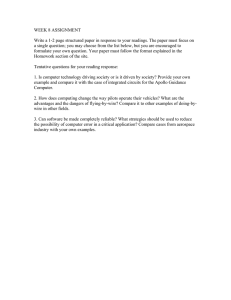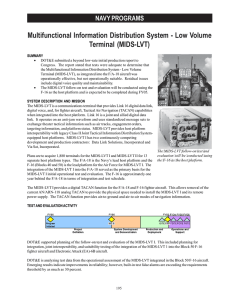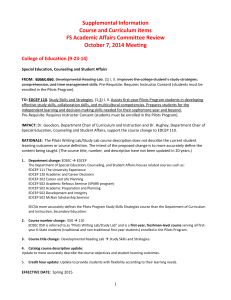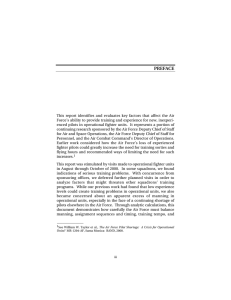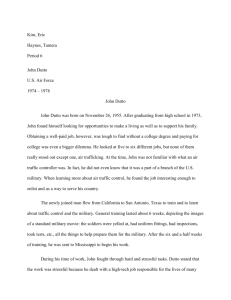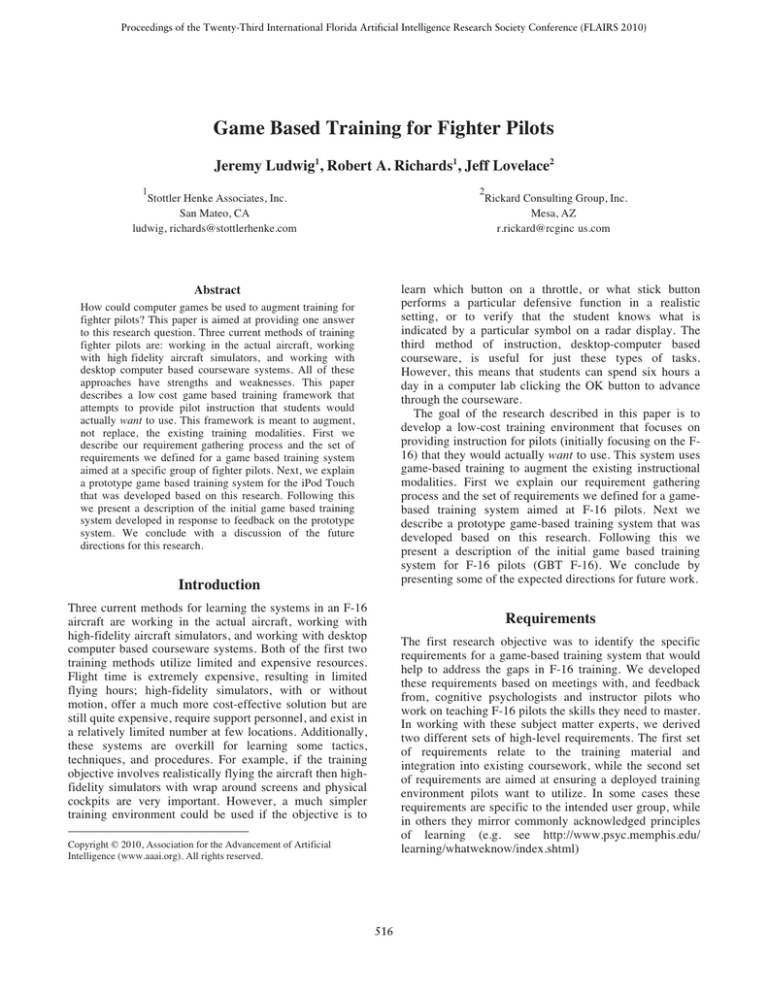
Proceedings of the Twenty-Third International Florida Artificial Intelligence Research Society Conference (FLAIRS 2010)
Game Based Training for Fighter Pilots
Jeremy Ludwig1, Robert A. Richards1, Jeff Lovelace2
1
2
Stottler Henke Associates, Inc.
San Mateo, CA
ludwig, richards@stottlerhenke.com
Rickard Consulting Group, Inc.
Mesa, AZ
r.rickard@rcginc us.com
learn which button on a throttle, or what stick button
performs a particular defensive function in a realistic
setting, or to verify that the student knows what is
indicated by a particular symbol on a radar display. The
third method of instruction, desktop-computer based
courseware, is useful for just these types of tasks.
However, this means that students can spend six hours a
day in a computer lab clicking the OK button to advance
through the courseware.
The goal of the research described in this paper is to
develop a low-cost training environment that focuses on
providing instruction for pilots (initially focusing on the F16) that they would actually want to use. This system uses
game-based training to augment the existing instructional
modalities. First we explain our requirement gathering
process and the set of requirements we defined for a gamebased training system aimed at F-16 pilots. Next we
describe a prototype game-based training system that was
developed based on this research. Following this we
present a description of the initial game based training
system for F-16 pilots (GBT F-16). We conclude by
presenting some of the expected directions for future work.
Abstract
How could computer games be used to augment training for
fighter pilots? This paper is aimed at providing one answer
to this research question. Three current methods of training
fighter pilots are: working in the actual aircraft, working
with high fidelity aircraft simulators, and working with
desktop computer based courseware systems. All of these
approaches have strengths and weaknesses. This paper
describes a low cost game based training framework that
attempts to provide pilot instruction that students would
actually want to use. This framework is meant to augment,
not replace, the existing training modalities. First we
describe our requirement gathering process and the set of
requirements we defined for a game based training system
aimed at a specific group of fighter pilots. Next, we explain
a prototype game based training system for the iPod Touch
that was developed based on this research. Following this
we present a description of the initial game based training
system developed in response to feedback on the prototype
system. We conclude with a discussion of the future
directions for this research.
Introduction
Three current methods for learning the systems in an F-16
aircraft are working in the actual aircraft, working with
high-fidelity aircraft simulators, and working with desktop
computer based courseware systems. Both of the first two
training methods utilize limited and expensive resources.
Flight time is extremely expensive, resulting in limited
flying hours; high-fidelity simulators, with or without
motion, offer a much more cost-effective solution but are
still quite expensive, require support personnel, and exist in
a relatively limited number at few locations. Additionally,
these systems are overkill for learning some tactics,
techniques, and procedures. For example, if the training
objective involves realistically flying the aircraft then highfidelity simulators with wrap around screens and physical
cockpits are very important. However, a much simpler
training environment could be used if the objective is to
Requirements
The first research objective was to identify the specific
requirements for a game-based training system that would
help to address the gaps in F-16 training. We developed
these requirements based on meetings with, and feedback
from, cognitive psychologists and instructor pilots who
work on teaching F-16 pilots the skills they need to master.
In working with these subject matter experts, we derived
two different sets of high-level requirements. The first set
of requirements relate to the training material and
integration into existing coursework, while the second set
of requirements are aimed at ensuring a deployed training
environment pilots want to utilize. In some cases these
requirements are specific to the intended user group, while
in others they mirror commonly acknowledged principles
of learning (e.g. see http://www.psyc.memphis.edu/
learning/whatweknow/index.shtml)
Copyright © 2010, Association for the Advancement of Artificial
Intelligence (www.aaai.org). All rights reserved.
516
The first set of requirements is aimed at developing
relevant training that makes efficient use of the student’s
time. First, the system should prepare pilots by training
towards identified mission essential competencies and
enhancing flight safety, in a way that allows for transfer of
learning from the training environment to the actual plane.
Second, the training games themselves should provide
guidance during the game to help the students make the
right decision the first time, rather than only providing
feedback in an after action review. This requirement
highlights a need to take advantage of intelligent tutoring
systems (ITSs) [e.g., see Woolf, 2008] to provide the right
information to the student at the right time. Third, the
system should support integration with a learning
management system that relates scores in games to desired
skills, in order to track performance and assign specific
training games to students based on their needs. This
would not necessarily mean that the system would become
part of the course requirements, but that the system could
point out to students the specific areas that they could use a
little more practice in.
However, as our discussions with subject matter experts
pointed out, students are busy. If a training program is only
available in the lab and is not a required part of the
curriculum, students won’t use it. Even when required,
some of the online training material is dry and the students
get easily bored with it. The second set of requirements is
aimed at ensuring that the students actually use the training
system. First, the system needs to be available. At a
minimum it should run on any desktop computer, including
home computers so students do not need to sit in the lab.
Ideally, the training environment would run on a portable
device so that students could work on skills whenever, and
wherever, they happen to have free time. Second, the
system needs to be inherently interesting to motivate
students to use it. One of the goals of game-based training
is to make training more fun, e.g. providing something that
engages students by tapping into their competitive spirits.
the radar system. In either single- or multi- player mode,
the student is asked to configure the radar to a given set of
settings. In multiplayer, the goal is to get the radar
configured first, and you can see your score relative to
your opponent as shown in Figure 2. This prototype uses a
simple form of hinting as a placeholder for a more
powerful intelligent tutoring system, where the next step is
given to the student below the radar screen if the student
seems to be stuck.
Figure 1: iPod prototype for Radar buttonology, with
the hint Select TWS displayed
Prototype Development
The second research objective was to create and
demonstrate a prototype system to provide a concrete
example of the envisioned training concept. The prototype
was developed on the iPhone/iPod Touch platform
(referred to as iPod from now on). Training on an iPod is
inherently available to students they can easily take it
everywhere they go. Additionally, the likelihood of some
content being used is increased simply by not requiring the
student to sit in the computer lab while working on it. The
iPod prototype also leveraged the competitive instincts of
fighter pilots for motivational purposes by including headto-head multiplayer games
it is fun to win. This
innovative prototype, having the potential to be fun to use,
provide valuable training, and serve as a resource center,
all at once, sparked significant interest.
The particular game developed for the iPod prototype,
shown in Figure 1, focused on teaching the buttonology of
Figure 2: Be the first to reach the given radar settings
on the prototype in head-to-head competition
517
The iPod prototype was demonstrated with the subject
matter experts and they responded enthusiastically to it,
including an unscripted example of how the system could
tap into their competitive spirits. The prototype was seen to
have the potential to be fun to use, provide valuable
training, and serve as a resource center all at once.
identified, combining audio-visual, game-based, and testpreparation elements into a single training application. The
GBT main screen is invoked by starting the application on
the iPod. Figure 3 illustrates the list of reference materials
and training games available to the student on the
application’s main screen.
Related Work
We concentrated our review of related work on existing
iPhone applications for training pilots. While a significant
amount of web-based training material exists that could be
accessed via wireless Internet, it did not meet our criteria
for availability as many of the intended client sites do not
have wireless Internet access.
There are a number of related iPhone applications
publicly available from the iTunes App Store. This is the
only approved method for selling applications to the
public, though like work presented in this paper it is
possible to privately release applications to a limited
number of users. We identified several types of related
public training applications: video-based, game-based, and
test-based, within the App Store.
The first type of training application uses the audiovisual
capability of the iPhone to play back pre-recorded training
videos. One example of this is VFR Communications [On
the Flight Line Productions, 2009], which plays back
training videos on user selected topics.
A second type of application is game-based training for
pilots, which we found to be primarily flight simulators.
Most the offerings are non-realistic, with many of the
fighter applications more akin to first person shooter
games. One exception to this is the X-Plane series of flight
simulators [Laminar Research, 2009]. Even when flight
simulators are more realistic it is not clear how learning
would be transferred from the iPod to the actual plane.
The third type of application is test preparation software.
These applications are more closely related to the work
described in this paper. Of the current iTunes App Store
offerings, all of the ones we identified focused strictly on
multiple choice questions. Some supply questions
randomly selected from a pool [Pusenjak 2008a, 2008b],
some remember the student’s index into a series of
questions [Hodapp, 2008], while others provide both
random questions and practice test modes [Aviation
Supplies and Academics, 2009]. All of these programs are
available only in single-player mode and rely exclusively
on multiple choice questions.
Figure 3: The main application screen, presenting the
reference viewer and a list of training games
Reference Viewer
The goal of the reference viewer is to augment all of the
large binders that the pilots are given with a customized list
of references that can easily travel with the student, as
shown in Figure 4. In the course of this research, we have
identified specific reference files essential to F-16 student
training. However, it is expected that in order to be most
useful, the files/links of the reference viewer will need to
be customized for each particular end user group, so the
list of references is easily updated by altering a
configuration file and including the appropriate reference
PDFs.
Games
Initial Training System
For most of the games, the user has a choice between
launching in single- or multi-player mode after selecting a
game. The single player version supports self-paced study
of topics, while the multi-player version focuses on more
engaging head-to-head competition. Currently, GBT F-16
supports two players, but the future versions will allow
four competing players, based on the functionality
provided by the iPhone software development kit. The
The initial Game Based Training for F-16 (GBT F-16)
system is a work in progress that demonstrates a pilot
training system that contains a reference viewer and
several single and multi-player games: Radar Buttonology,
Symbol Recognition, Visual Recognition, Master Question
File, and Comm Format. This system blends elements from
all three types of training applications previously
518
initial version of GBT F-16 supports five different training
games: Radar, Master Question File, Visual Recognition,
Communications Format, and Symbol Recognition.
Figure 5: Getting a MQF multiple choice question
wrong (red) with the correct answer shown (green)
Visual Recognition. The visual recognition game (Figure
6) is another take on the quiz style of game. In this case, an
image of a platform (e.g. aircraft) is presented for 1
second, followed by three seconds to pick an answer. The
quiz feedback is a little edgier than found in standard
training programs, with statements such as “Are you sure
you’re a Fighter Pilot?” when the student answers
incorrectly. This feedback style was suggested by two
experienced instructor pilots, and is somewhat at odds with
research investigating the utility of polite feedback
[McLaren et al, 2007]. However, the instructors’ intuition
was that this type of feedback would have greater
resonance with F-16 pilots than polite feedback.
Figure 4: List of PDF references for F-16 pilots
Radar. This game focuses on teaching the buttonology of
the radar system. In either single or multi- player mode, the
student is asked to configure the radar to a given set of
settings by touching the appropriate soft key buttons on the
iPod touch screen. In multiplayer, the goal is to get the
radar configured first, and you can see your score relative
to your opponent as shown in Figure 2.
Master Question File. The Master Question File (MQF)
game is aimed at allowing students to practice for their
MQF tests. It is based on a standard quiz format,
presenting a question through text, pictures, video, or audio
(or some combination) followed by multiple-choice
answers. The prototype contains a number of sample MQF
questions as shown in Figure 5, where the user has selected
an incorrect answer. An example question is: A 2000-foot
acceleration check speed will be computed anytime
computed takeoff roll exceeds (
) feet. When computed
takeoff roll is less than or equal to this number, use actual
takeoff distance versus computed takeoff distance to
evaluate aircraft performance. a.1500 b. 2000 c. 2500 d.
3000 Answer: c
Communications Brevity Format. Pilots depend heavily
on brevity words to say as much as possible without having
to talk on the radio for a long time. For instance, during
air-to-air targeting of a group of aircraft, there are required
calls in a specific format that must be made. Talking and
flying in the tactical arena is a very difficult skill to
develop in young aviators, and, critically, the more practice
they get, or examples they hear, the better. Instructor pilots
are adamant about proper communication examples in the
flight briefing. The mantra is “if you can’t say it correctly
at zero knots and one G, you definitely won’t say it
correctly in the heat of battle.”
The communications format game makes use of sound
clips of radio calls or text, of the format “Viper 1 singer 6
north defending 280”. The student would then correct the
519
statement by dragging and dropping the pieces into the
correct statement. In this case it would be “Viper 1 singer 6
280 defending north.” An example of this game is shown
in Figure 7.
in the simulated display as fast as they can. A sample
question from the symbol recognition game is shown in
Figure 8.
Figure 8: Symbol recognition game where the student
has selected the correct symbol
Figure 6: Visual recognition game
Conclusion
To summarize, this paper described progress on three
specific research objectives. First, we analyzed training
needs of F-16 pilots and defined training system
requirements. Second, we developed and demonstrated an
initial prototype. Based on the response to this prototype
concept, we went on to develop an initial version of the
GBT F-16 training system as a vehicle in which to
demonstrate its training possibilities. However, a
significant amount of additional work is required to
develop this into a deployable system. We describe three
specific areas of future improvement.
First, we envision creating a general GBT framework
that would be re-used across pilot training programs to
support the creation training systems for different aircraft,
such as the upcoming F-35. The framework would contain
the general implementation required to support a variety of
training programs, such as a game plug-in manager
responsible for loading domain-specific games for a
particular aircraft, as well as game-templates to ease the
construction of domain-specific games.
Second, we envision an intelligent tutoring system that
would fill multiple roles in the GBT systems. The ITS
would be responsible for creating a student model that
Figure 7: Communication format game
Symbol Recognition. The symbology recognition game
addresses the problem of understanding complex and
crowded displays. The horizontal situation display in the
aircraft is filled with information…too much in some
cases. There are numerous symbols of different colors and
shapes that mean completely different things. Being tested
on timely comprehension of symbols is invaluable to
training, as this is an area where practice makes perfect.
Questions in this game pit one pilot against another
based on the time required to figure out what a single
symbol is, by asking the player to select a specific symbol
520
reflects scores received on the games, in both single-and
multi-player modes. This model provides an overview of
performance both within individual games and across the
entire training package. Eventually, this information would
feed back into a learning management system. The ITS
would also function within games, appropriately
scheduling multiple choice questions based on the student
model in quiz games and helping the student learn the
correct concept by providing advice/feedback while the
student is playing other types of games. A simple example
of providing advice is shown in Figure 1, where the player
seems to be stuck when trying to reach the desired radar
settings. We envision that advice/feedback would be
implemented using solution template techniques that have
been previously applied to military training domains
[Ramachandran et al., 2008]. However, a significant
research question to be answered is how to best translate
the ITS user experience from desktop computing to an
iPhone-based tutoring experience. Brown et al. [2008] lay
out a number of research questions on the use and
implementation of mobile intelligent tutoring systems
Third, the games and reference viewer in the initial
version of GBT F-16 are in their proof-of-concept phase.
Each of these games is missing key features as currently
implemented (e.g. PDF search in the reference viewer;
performing a mock test in the solo version of the Master
Question File game). Additionally, all of the existing
games have only limited content behind them, from only
one or two examples up to twenty examples. We have also
identified additional games; these would expand the
number of games available to F-16 pilots, for example
providing instruction on audio-tone recognition or preflight check procedures. Finally, additional research would
likely yield a number of potential games and game play
styles that could be added to this system, such as pitting
cooperative teams against one another. Future work would
address each of these topics in further developing the
domain specific games available for F-16 pilots.
References
Aviation Supplies and Academics (2009). Prepware
Private
Pilot.
Retrieved
from
http://itunes.apple.com/us/app/prepware-privatepilot/id334278376?mt=8.
Brown, Q., Lee, F., Salvucci, D. and Aleven, V. (2008).
The design of a mobile intelligent tutoring system.
Proceedings of
the International Conference on
Intelligent Tutoring Systems, Montreal, Canada.
Hodapp, N. (2008). PilotPrep. Retrieved from
http://itunes.apple.com/us/app/pilotprep/id293831424?m
t=8.
Laminar Research (2009). X-Plane 9. Retrieved from
http://itunes.apple.com/us/app/x-plane9/id290619945?mt=8.
McLaren, B. M., Lim, S., Yaron, D., & Koedinger, K. R.
(2007). Can a polite intelligent tutoring system lead to
improved learning outside of the lab? Proceedings of the
13th International Conference on Artificial Intelligence
in Education (AIED 2007).
On the Flight Line Productions (2009). VFR
Communications.
Retrieved
from
http://itunes.apple.com/us/app/vfrcommunications/id328833128?mt=8
Pusenjak, I. (2008a). FAA Test Prep
Private Pilot.
Retrieved from http://itunes.apple.com/us/app/faa-testprep-private-pilot/id288783667?mt=8 .
Pusenjak, I. (2008b). FAA Test Prep Instrument Rating.
Retrieved from http://itunes.apple.com/us/app/faa-testprep-instrument-rating/id290828856?mt=8 .
Ramachandran, S., Ludwig J., Salas E., Rosen M. (2008).
A methodology for simulation-based job performance
assessment. Proceedings of the Industry/Interservice,
Training, Simulation & Education Conference (I/ITSEC
2008).
Woolf, B. P. (2008). Building intelligent interactive tutors:
Student-centered strategies for revolutionizing elearning. Morgan Kaufmann.
Acknowledgements
This work was funded by the Air Force Research Lab
under the direction of Dr. Winston Bennett and LT Joel
Walker, contract #FA8650-09-M-6986. The views,
opinions,
and/or
findings
contained
in
this
article/presentation are those of the authors/presenter and
should not be interpreted as representing the official views
or policies, either expressed or implied, of the Air Force
Research Lab or the Department of Defense.
521


